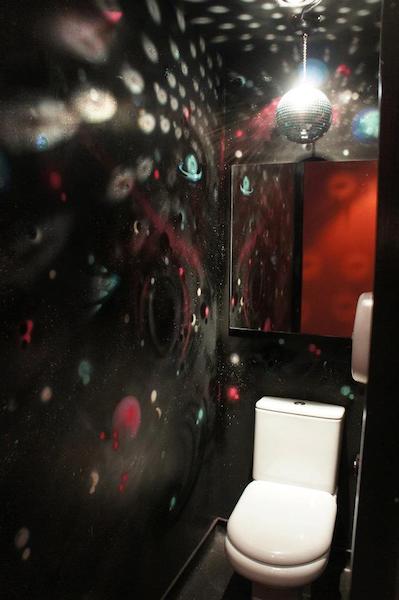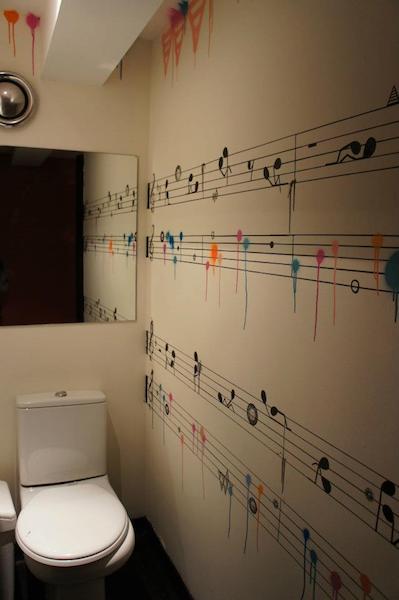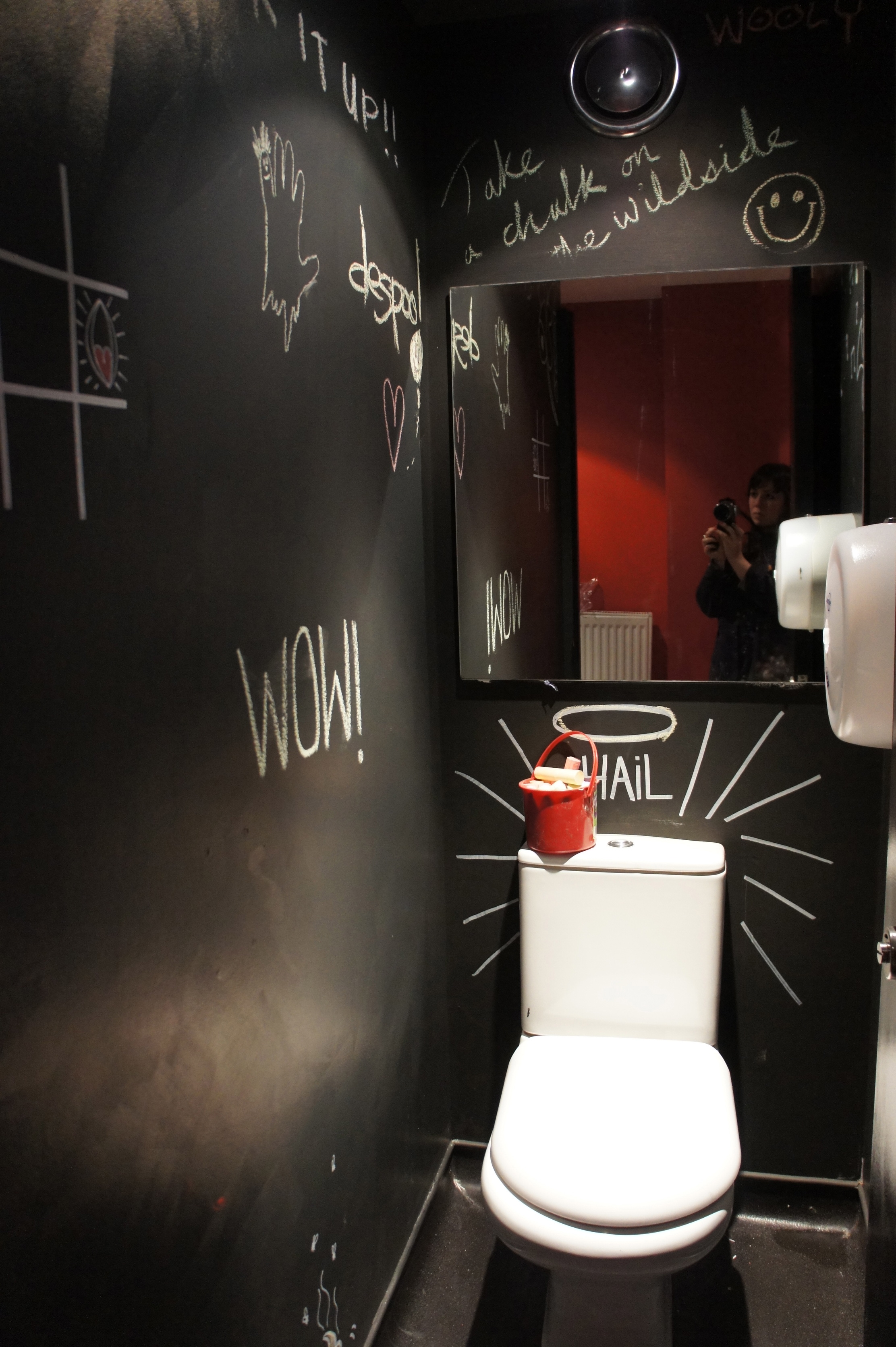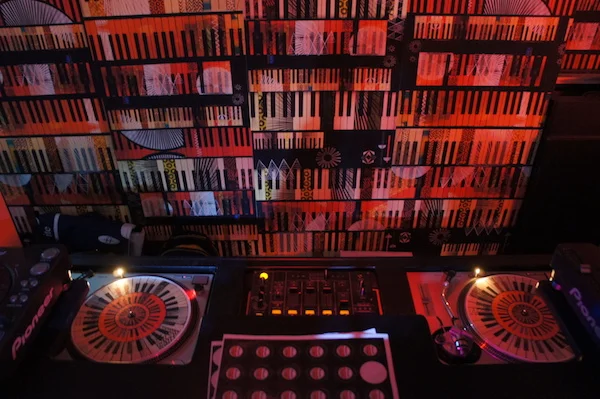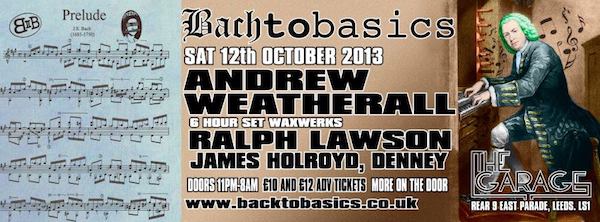The Garage - Paradise lost
/Beginnings
Clubs open in the most unusual places, one of the coolest clubs in London from 2005 was Kubicle that took place in an old Victorian toilet called Public Life. So perhaps it didn’t seem that strange an idea to open a new venue in a car park below a Karaoke bar, slap bang in the middle of Leeds business district. Deciding to cut up a Chevrolet fire truck to act as a DJ booth might also seem an odd decision but that’s exactly what the founders; Stephen Hawkins (not that one), Tristan Da Cunha and Iain French (aka Frenchy), decided to do. Although the name came directly from the fact that it was indeed a garage, a nod to the legendary New York Paradise Garage was also welcome. Finding an original 1982 fire truck used by the New York fire department on e-bay couldn’t have been a more perfect fit for the project.
Cutting up the truck was also inspired by another influential club, back to basics, as Da Cunha explains…
“The whole project was what I call a YES project …YES let’s do this , YES let’s do that , our imaginations were running wild and we were so excited to be doing it . Because the venue was basically a garage in an old fire station it made perfect sense to us to have some kind of truck in there. It was also a little nod to the first back to basics venue, The Music Factory, which had a truck as a DJ booth.”
“When it got installed we were just ecstatic . We knew we didn’t really need to do much else with the club space, that was the show piece . It felt like a piece of art sitting there with it’s beaming lights in the fog of the smoke machine. It was like something out of a Stephen King movie. It looked really mean and sinister in the best possible way”.
The first nights at The Garage were called Lowbrow but the space really took off when it was used by mono_cult for an after party with Axel Boman. Hawkins describes the event…
“We had a graffiti artist from Leeds, Ashbury Levi aka Goo Burr, to do the walls. I remember about 9am having to open the main doors to let some air in, daylight came flooding in like Panorama Bar. Everyone thought it was over then 10 minutes later we closed the main garage doors again and it went on for another 4 hours. That was a turning point for me, when I realised something incredible could be done here”.
Victoria Topping
Hawkins decided to approach Da Cunha and Frenchy to look at all the space available in the venue and discuss further ideas. The pair had previous experience working and running record stores, notably Play Music in the Corn Exchange, and excellent taste in a wide range of music. So the idea formed to create a unique space that incorporated a club but also a social area with a record shop and bar for people to hang out. Da Cunha has a keen eye for design and suggested bringing in Bristol based artist Victoria Topping to design key areas of the venue.
“Victoria came up to see the space and things just snowballed . We custom made everything, even down to the slip mats for the turntables . There was just this beautiful thread and theme that flowed through the whole venue . The club was quite minimal then as you walked down the hall things started to get really interesting including individually designed toilet cubicles”.
”The Waxwerks record store felt like an art gallery crossed with a speakeasy. It was pretty much a Victoria Topping x Garage permanent art exhibition. With such a strong identity it made total sense for Victoria to do all our artwork for promotion as well, flyers & posters were all designed by her. What I loved about it was we had our own resident artist which I don’t think anyone has done since Keith Haring at the Paradise Garage”.
One of my earliest memories of going to house clubs was visiting High on Hope at Dingwalls in London in 1989. I remember entering the venue and seeing Keith Haring artwork painted in dayglo colours on black sheets. That artwork left a big impression on me and formed the basis of my belief that art and visuals play a crucial role in the clubbing experience. Although we are now used to having huge LED screens project visuals alongside incredible light shows, I still feel that very few venues incorporate the possibilities of showing art or using artists in venue design. It was interesting to read, while researching this piece, that Norman Jay who was the resident DJ at High On Hope started the night after a trip to New York where he too was inspired by the Paradise Garage. Keith Haring never missed a Saturday night on the hallowed dance-floor and his artwork is forever connected to the club. I asked Victoria Topping about the inspiration behind the design,
Was there a conscious nod to Keith Haring, especially with the name of the club reflecting the name of his beloved Paradise Garage ?
“Absolutely! Im a disco queen at heart so am incredibly inspired by the early New York dance scene. If I could get hold of a time machine I would head straight to the Paradise Garage. I’m also very inspired by the way Keith Haring’s work was integral to the scene and the music. Its a idea I have tried to recreate in my own way”.
Waxwerks
The completed venue with The Garage and Waxwerks record store officially opened it’s doors on March 31st 2012. Waxwerks became a weekly visit. Tristan has sourced records for me for as long as I can remember. Even when he wasn’t working in record stores he would always greet me with, “Have you heard this? It’s ace mate!”. It’s the essential character and skill of every good DJ to communicate their passion and spread good music. I don’t think it’s any co-incidence that several back to basics DJs cut their teeth in record stores. Frenchy also played a crucial part at The Garage as a resident DJ and is truly one of the unsung heroes of house in the city. A tall, gentle soul he always greets you with a smile and story. Between the pair of them Waxwerks exuded one of the most positive and forward thinking atmospheres of any record store I’ve frequented. They also pulled off some staggering in-store guest appearances as well as booking emerging talent well before breaking. As Frenchy explains,
“The in-store sessions we did on a Saturday afternoon would be crazy. We had Apollonia, Mark Farina, Motor City Drum Ensemble, Chez Damier and Mark Seven all rocking up and playing and we’d have people queuing round the block to get in at 3pm on a Saturday”.
The Moment
The Garage brought in back to basics for Saturdays which produced some memorable nights for me as a resident, including being re-united with an old friend and production partner Chez Damier. I first recorded with Chez in 1992 after meeting him in New York at The Sound Factory. We produced records under the name ‘Chuggles’ for Prescription Underground and also one very special record called ‘A Dedication to Jos’, named after my girlfriend who was killed in a car crash the following year. Meeting Chez again was very strange. We had basically gone away and lived entirely separate lives since that first encounter exactly 20 years previously. Chez had even given up music for a while and worked in the corporate world while I had got married and brought up a family. Yet the original connection was still there. We managed to have one day in the studio after the gig and made a track called ‘The Moment’.
Connections
Connections like these are one of the aspects of clubs that interest me the most. I met my wife in a club, I met most of my best friends in a club, I have spent my working life in clubs. People meet people in clubs and forge relationships, both romantic and creative. Perhaps the most interesting meeting of minds that came about at The Garage was the introduction of Underground Paris (later known as My Love is Underground) , through Tristan Da Cunha. Once again it was a story of personal relationships that turned into creative output. As Tristan recounts,
“Like many of my really good friends we met through music and the mutual common ground that you find so often when meeting other people who are as passionate about music as yourself. When My Love Is Underground started I got the first Nathaniel X EP and contacted Jeremy Underground congratulating him on a fine release. Then he followed up with the killer Paris Underground Trax Vol 1. I was all over it and got in touch again saying how much I loved his new EP. He swiftly got back in touch with me to inform me that the EP wasn't by him but was in fact by someone else whose identity was being kept secret. I said cool, I like a bit of mystery behind my music. A day or so later I got an email from the guy who'd actually made the EP. It's a funny story as the man behind it was Brawther. Years before he started to make music or DJ he was living in England on an exchange and he came to back to basics, saw me play and contacted me on MySpace to say how much he'd enjoyed my set and asked what a certain track was. I thought nothing more of it until I got this email saying “Hey it's me from years ago, the guy from MySpace”. I was like, “FUCK RIGHT OOOOOFFFF, dude your new EP is killing me, it's awesome!”
That one message sent from Tristan connected the dots in a way he couldn’t possibly have imagined. It brought about not only a regular MLIU night at back to basics but also the start of a production partnership between Da Cunha and Brawther that turned into the Dungeon Meat project. That then spawned the underground club hit that defines the entire Garage period for me, the aptly named ‘The Fuck Off Track’. Which label did it come out on ? My Love is Underground, of course. That’s how these things happen. Connect the dots.
Best Club
Dave Beer’s back to basics took the flagship Saturday night at The Garage, where it was able to return to it’s underground house roots. There were memorable sets from; KiNK & Neville Watson Live, Derrick Carter (yet again), Subb-an & Shelton, Delano Smith, Mr G Live, Alex Arnout, Tuccillo & Willie Graff among others. The venue also enlisted the next generation of promoters, many of whom went on to forge significant event brands, including Set One Twenty, Selective Hearing, Beat Street and Nest. These then contributed to widening the talent pool and included appearances from artists that you surely won’t see in a small club now - Claptone and the first show in the city after returning to house music from Mark Kinchen pka MK. There were also memorable performances from Redshape Live, Skudge, Mark Farina, Ivan Smaghhe, Terence Parker, Prosumer & Virginia, Jane Fitz, The Revenge, Linkwood, Soul Clap, Steffi, Gerd, Pional and Nicolas Live.
At the end of 2012, just 9 months after opening The Garage was nominated and won Best Small Club at the DJ Magazine Best of British awards. Awards always help by bringing attention and bigger numbers, as well as creating a national presence. People start to travel from outside the city to come to the club. Things were really starting to bubble along nicely in the new year and by March 2013 the dream of a building the equivalent of a mini Panorama Bar (Berlin) or Robert Johnson (Frankfurt) in Leeds was becoming a reality.
The beauty of small clubs is that they allow for experimentation. There are perhaps 300 people in front of the DJ and they are generally there because they are music fans first and foremost rather than along for the ride. At the Garage this meant not only experiments in electronic music but also the possibility of creating the ‘Disco Till I Die’ night featuring sessions from Maurice Fulton, Popular People’s Front and Mark Seven. Victoria Topping once again came through with the artwork and created the kind of event poster that gets stolen from walls.
I hear the music
Usually I create unique mixes for the basic vision blog. These have been greatly rewarding and well received but they are recorded in hindsight and time has a tendency to colour the reality. I started recording new mixes mainly because there were just so few recorded at the time. Something I find quite upsetting, yet in a way liberating, is that we were so slack at recording. One way of looking at it is that the shows were purely a live experience and memories are worth a thousand recordings. Yet what happens when the memories fade and imagine the archive we would have created if we’d recorded 27 years of back to basics night. All in all, I sincerely hope that future club runners manage to press the record button and artists allow them to do so. For this part of the basic vision series I discussed the possibility of following the format and recording a Garage mix with Tristan & Frenchy but we all felt that the club was just too short lived to do the job justice. So instead I decided to post a really superb ‘Disco Till I Die’ mix recorded by the duo and the one guest session that I did actually make sure to personally record - Andrew Weatherall. I am so glad I decided to take down my trusty Tascam DR40 to Waxwerks the night he played a 6 hour set on October 12th 2013, it is still one of the best eclectic balearic sessions I’ve ever heard. Anyway I’ve included them all below -
You lot
Of course a good club is only as good as it’s crowd. The Garage attracted a very cool set of regulars and inspired many people that went on to do great things in the city and beyond. It is not quite clear how the venue managed to stay open until 8am other than Hawkins assertion that,
“I think we made a strong case to extend the license. My history in the city centre of running late venues helped. We ran a totally clean sheet with the licensing team, it was a very safe place. We had the lowest record for bag and phone thefts and made a big effort to get lost items returned to our customers. But that license wasn’t sustainable long term, I already had to rent out the flat opposite due to noise complaints”.
But those extended hours, cool interior and excellent music often resulted in scenes like these,
I see you baby ! Damian from Zutech / The Warehouse Project spotted by mystery girl.
Changing times
We are currently living through very changeable times in nightlife. Over the past decade there has been a widespread and widely reported decline in music venues across the world. Especially hard hit have been small clubs. However, my observation is that this is old news and judging by Leeds, London and Berlin there are actually a wealth of newly opened independent venues. The model has had to change though and nearly all survive by being multi-purpose. This has led to the rise of multi-floor venues, seen so successfully in Leeds at venues like The Belgrave Music Hall, which opened in 2013. The Garage was definitely on the right pathway and pre-dated this current trend with it’s mixed use space by over a year. There was the potential to open up the floor above and take over the Karaoke room. In fact for the basics birthday and New Years Eve 2012/13 the whole venue was used successfully with the Karaoke room’s red velvet curtains and booths adding a alternative certain kitsch cool to downstairs.
However small clubs manage to survive it is essential for all genres of music that they do just that. The new generation of mega venues like Printworks in London or The Warehouse Project in Manchester are hugely impressive and certainly know how to deliver an incredible show. Yet their sheer size dictates that the acts booked must be at a certain level. Small clubs are always the route for aspiring artists on their way up the ladder and without them we lose access routes for emerging talent, making it increasingly difficult for the next generation. There is also the case that both DJs and customers just love to play and party in smaller venues, where they can connect closely with the crowd and play a wider selection of music.
I asked Tristan Da Cunha, do you think small venues have a future in clubbing ?
“In my opinion small clubs are an essential part of the scene and moving it forward. They are needed to nurture the next generations of DJ’s, artists, promoters. Smaller spaces take the emphasis off ‘bums on seats’ and push the envelope for the art and the craft. Allowing new exciting faces and forces to experiment and express themselves. People need the smaller venues to build scenes, communities and movements. Without them there’s no intimacy to nurture the relationships that are needed to cross pollinate the different crews, labels, genres and art forms. I personally just love to party and perform in a smaller space. The dialogue between the floor and the booth is just loads more personal and vibrant. For me it’s all about the small clubs and spaces They usually have the best vibes on the dance-floor”.
Set One Twenty
The Garage - Paradise Lost
Then it all came to an abrupt and sudden end. There had been no public warning and the news came as a shock to all, including even Iain French who describes the scene,
“I turned up at work, the locks had been changed and that was that, no more Garage. We were shell shocked, heartbroken, and also felt a big burden of responsibility for the promoters who had DJ’s booked in for nights and future plans laid, as well as all our staff. Fortunately we had really good relationships with everybody, they could tell we were genuinely as surprised and gutted as them. We had lost our jobs too, so everyone was as cool as they could be about it.”
On November 13th 2013 The Garage put out an official statement that read,
“A minor tragedy has befallen the Leeds clubbing landscape today: The Garage is having to close its doors with immediate effect. No one is strictly to blame; rather the current landlord has decided he does not want to extend the tenancy”.
It was hardly a detailed or satisfactory statement and for the people involved the closure was also not, “a minor tragedy (sic)” but a major disaster. As French points out people lost their jobs without warning. Five years later and that sense of not knowing the full story behind the extremely rapid demise of the club remained. Normally a business signs a lease lasting for a long period, several years in the case of venues. The lease renewal date is also well known in advance so if anything does go wrong with the business then the employees are given enough notice. So, I asked Stephen Hawkins,
What really happened ?
“The truth is I had bought out all my partners in Ok Karaoke and the building, part of that process was re-negotiating the terms of the lease with the landlord, which was very high rent and not favourable. Initially I agreed to his demands that the new business should pay what the old one did as I did not want to see Ok Karaoke or The Garage close. The negotiations got tougher and in the end I made a stand on what I thought the rent should be and nothing more. I knew that could cost me the business but without the right deal there was no business. At that stage we weren’t in a formal lease so he basically said, “no chance”, and locked the doors…”
The reality is that running a club in a city centre is an extremely risky business. The rent and rates are high, the hours are anti-social and they do tend to stick out like a sore thumb sitting next to the accountancy firms and smart restaurants. Residents also play a big part and of course noise complaints can de the downfall of any venue. It has been good to see that music venues have recently acquired greater protection including property developers having to pay for sound proofing. But all this came far too late for The Garage, it just shows that even an award winning club is at risk if it can’t balance the books.
Keeping on
After speaking to everyone involved there was an overwhelming response that no one wanted to dwell on the reasons behind the closure or held any animosity. The Garage lasted just 18 months but it burned very brightly indeed. All the people involved still feel incredibly positive about the experience and all have gone on to continue their paths in music, events and art albeit in different locations and fields. It is really lovely to see Victoria Topping now extremely hot property in the art world, even realising her dream commission of designing a record cover for her musical hero Sun Ra and The Lost Arkestra. She is also artistic director for ‘On The Corner Records’, who recently won Gilles Peterson’s record label of the year, 2018.
I asked her if new clients had come from her work at The Garage ?
“When I did The Garage it was very early days for my career but as the club has since become legendary I gained many new fans and worked with lots of people off the back of the work I did there. I don’t believe I would be where I am now without The Garage and Tristan.”
Alongside many others I personally miss Waxwerks the most, even though we now have a host of new record stores in the city including the excellent Tribe Records and Disque 72 Social. There are also several excellent small venues of a similar capacity like Wire and Sheaf Street. I had to ask Tristan & Frenchy if they missed the place and were there any plans to do another store,
Frenchy,
“We were certainly very proud of what we created with the store. We wanted it to be the antithesis of the stuffy/slightly intimidating vibe that you could often find in record shops. Very welcoming, very homely, a real cultural hub and a place where people would come whether they wanted to buy music or just hear music- as if you were hanging in your friends lounge, which also happened to have a bar and the best record collection in town!
In answer to the question do I miss the place? Do I miss that place! That was my baby and an absolute dream job for me. As much as I miss the club, I would say I miss Waxwerks more as it was such a nice place to hang out and I spent most days there”.
Tristan,
“Have I considered doing another one ? Yes, but it’s so time consuming that I don’t really want to fill my time in the retail world . Now I’m more focused on making the music, collecting and playing it”.
The final Victoria Topping piece for The Garage sums it all up perfectly…
It was only 18 short months but that’s long enough to make a chart isn’t it. Here is a short list of tracks selected from The Garage. Please feel free to post more in the comments and also share your experiences. I can only give my version of events and talk to the people involved but there are so many more stories out there…





